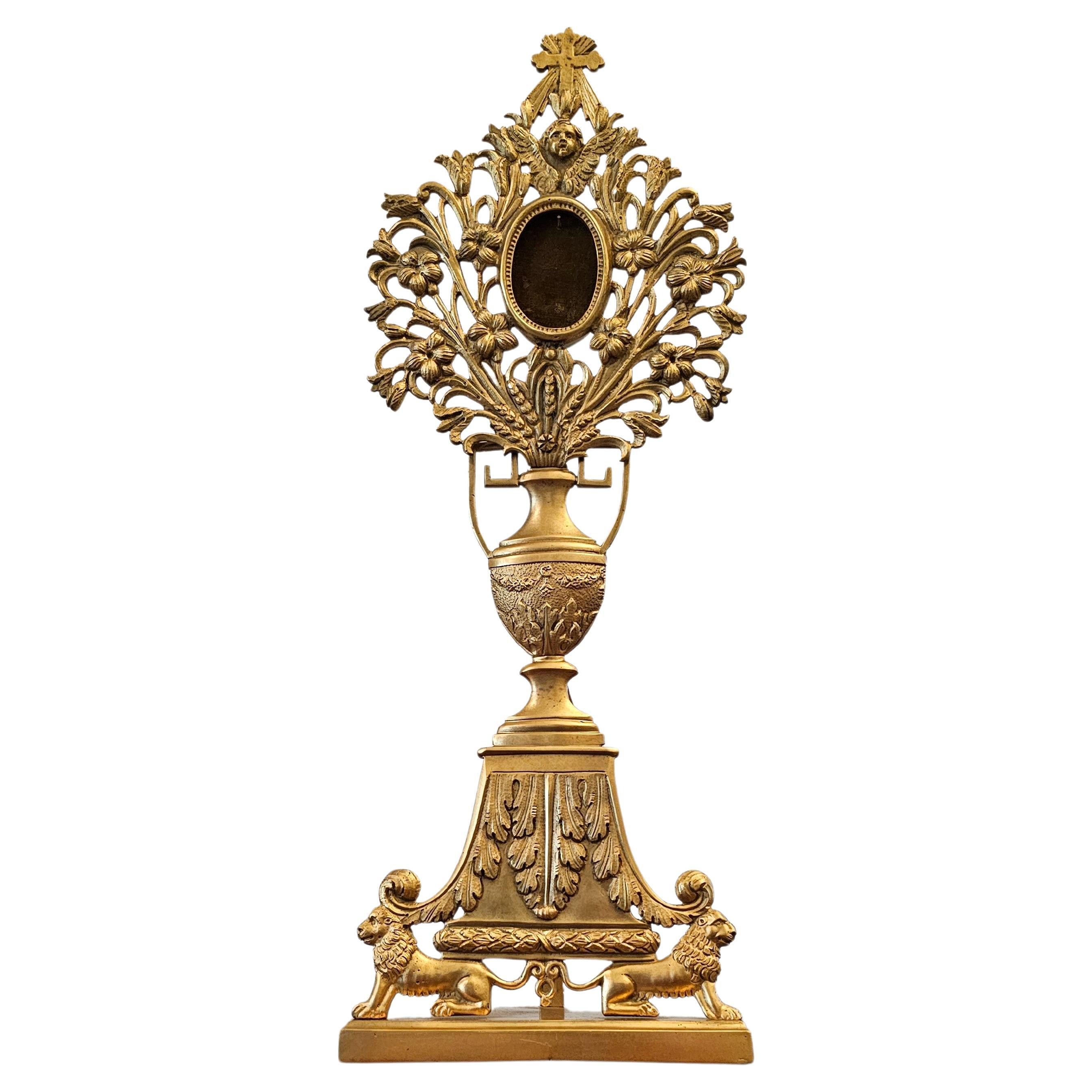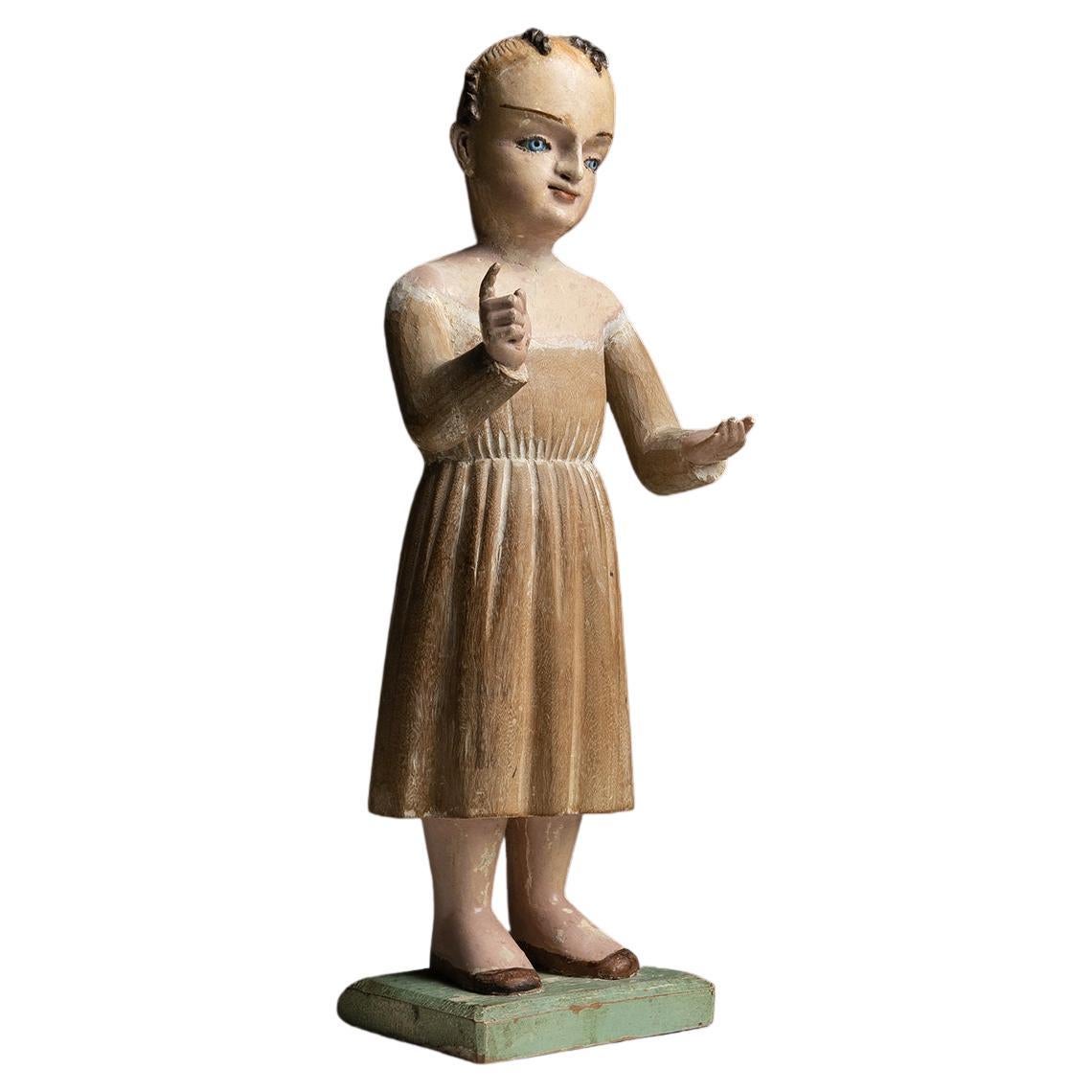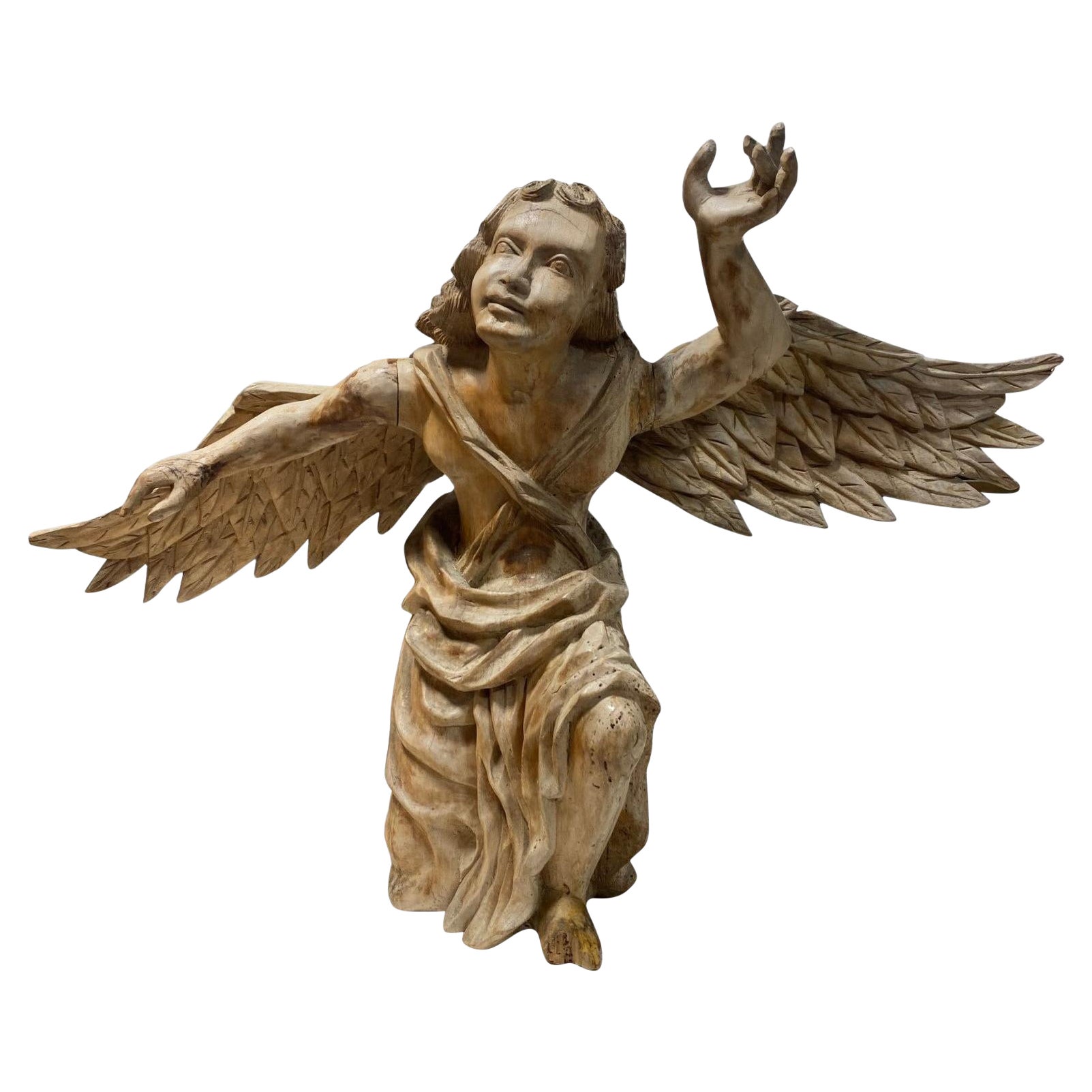Items Similar to 18th/19th Century Italian Baroque Silvered Metal Altar Monstrance Reliquary
Want more images or videos?
Request additional images or videos from the seller
1 of 19
18th/19th Century Italian Baroque Silvered Metal Altar Monstrance Reliquary
About the Item
A stunning antique Italian Baroque style silvered metal gilded wood monstrance reliquary. circa 1770-1820
Handmade in Italy in the late 18th / early 19th century, commissioned by the church to display an important religious relic, sculptural painted wood form, mounted with decorative silver repousse metal facing, open oval window where the philatory relic was once housed, rising on a gold gilt painted shaped plinth base.
Dimensions: (approx)
17" High, 8" Wide, 5" Deep, 1.25lbs
History:
Reliquaries (also referred to as a shrine or châsse in French), are containers used to protect and display relics. A portable reliquary may be called a fereter, and a chapel in which it is housed a feretory. A monstrance, also known as an ostensorium (or an ostensory), is a vessel used in Roman Catholic, Old Catholic, High Church Lutheran and Anglican churches for the display on an altar of some object of piety, such as the consecrated Eucharistic host during Eucharistic adoration or Benediction of the Blessed Sacrament. It is also used as reliquary for the public display of relics of some saints.
The use of reliquaries became an important part of Christian practices from at least the 4th century, initially in the Eastern Churches, which adopted the practice of moving and dividing the bodies of saints much earlier than the West, probably in part because the new capital of Constantinople, unlike Rome, lacked buried saints. Relics are venerated in the Oriental Orthodox, Eastern Orthodox, Roman Catholic and some Anglican Churches. Reliquaries provide a means of protecting and displaying relics. While frequently taking the form of caskets, they range in size from simple pendants or rings to very elaborate ossuaries.
The relics were enshrined in containers crafted of or covered with gold, silver, gems, and enamel. These objects constituted a important form of artistic production across Europe and Byzantium throughout the Middle Ages.
Many were designed with portability in mind, often being exhibited in public or carried in procession on the saint's feast day or on other holy days. Pilgrimages often centered on the veneration of relics. The faithful often venerate relics by bowing before the reliquary or kissing it; those churches which observe the veneration of relics distinguish between the honor given to the saints and the worship that is due to God alone.
Sixteenth-century reformers such as Martin Luther opposed the use of relics since many had no proof of historical authenticity and objected to a cult of saints. Many reliquaries, particularly in northern Europe, were destroyed by Calvinists or Calvinist sympathizers during the Reformation, being melted down or pulled apart to recover precious metals and gems. Nonetheless, the use and manufacture of reliquaries continue to this day, especially in Roman Catholic and Orthodox Christian countries. Post-Reformation reliquaries have tended to take the form of glass-sided caskets to display relics such as the bodies of saints.Relics of the True Cross became very popular from the 9th century onward and were housed in magnificent gold and silver cross-shaped reliquaries decorated with enamels and precious stones. From about the end of the 10th century, reliquaries in the shape of the relics they housed also became popular; hence, for instance, the skull of Pope Alexander I was housed in a head-shaped reliquary.
Relics play a major role in the consecration of a church. The consecrating bishop will place the relics on a diskos (paten) in a church near the church that is to be consecrated, they will then be taken in a cross procession to the new church, carried three times around the new structure and then placed in the Holy Table (altar) as part of the consecration service.
Many tales of miracles and other marvels have been attributed to relics beginning in the early centuries of the church.
- Dimensions:Height: 17 in (43.18 cm)Width: 8 in (20.32 cm)Depth: 5 in (12.7 cm)
- Style:Baroque (Of the Period)
- Materials and Techniques:
- Place of Origin:
- Period:
- Date of Manufacture:circa 1770-1820
- Condition:Wear consistent with age and use. Excellent original antique condition with nicely aged warm patina.
- Seller Location:Forney, TX
- Reference Number:1stDibs: LU5977233648672
About the Seller
4.8
Platinum Seller
These expertly vetted sellers are 1stDibs' most experienced sellers and are rated highest by our customers.
Established in 2013
1stDibs seller since 2021
200 sales on 1stDibs
Typical response time: <1 hour
- ShippingRetrieving quote...Ships From: Forney, TX
- Return PolicyA return for this item may be initiated within 7 days of delivery.
More From This SellerView All
- Fine 19th Century European Gilt Bronze Ormolu Monstrance ReliquaryLocated in Forney, TXA scarce fine quality neoclassical Empire style vasiform gilt bronze ormolu church religious relic altar monstrance reliquary. Exquisitely hand-crafted in Continental Europe in the second half of the 19th century, most likely French Napoleon III Period (1852-1870), having a fanned cross crest, above winged angel mask, central oval display...Category
Antique 19th Century European Empire Sculptures and Carvings
MaterialsBronze, Ormolu
- 18th/19th Century Spanish Colonial Carved Polychrome Wood Santo Altar SculptureLocated in Forney, TXA most impressive antique Spanish Colonial hand carved polychromed wood Santo Catholic church altar figure. circa 1800 Hand-crafted in the late 18th / early 19th century, exceptionally executed intricate detailing, the large scale antique religious sculpture depicting the female Saint Teresa of Avila, polychrome painted gesso over finely sculpted wood, inset glass eyes, shown in Carmelite nun habit...Category
Antique Late 18th Century Spanish Colonial Sculptures and Carvings
MaterialsGesso, Wood, Paint
- Important Early 18th Century Italian Carved Monstrance Reliquary TabernacleLocated in Forney, TXImportant and historic, acquired from the estate of legendary American businessman, the late T. Boone Pickens, we're proud to offer this exceptional carved giltwood reliquary - monstrance from the early 18th century. Elaborately hand carved in period Rococo - Rocaille taste, with superb scrollwork, openwork, fanciful acanthus leaf and shell, ornate detailing, polychrome painted warm pastel colors, now beautifully distressed, muted tones, with remnants of gold gilded accents. Pieces such as this were used in early churches for convenient exhibition or public display of some object of piety and other important religious relics...Category
Antique Early 18th Century Italian Rococo Religious Items
MaterialsGiltwood
- 18th Century German Baroque Architectural Putti Bust Wall Shelf CarvingLocated in Forney, TXA finely carved Baroque period architectural element, now fashioned as a sculptural bracket shelf. Hand-crafted by a master-artisan in the 18th century, originally part of a corbel...Category
Antique 18th Century German Baroque Sculptures and Carvings
MaterialsWalnut
- Baroque Period European Antique Carved Polychrome Santo Altar FigureLocated in Forney, TXA scarce Baroque Period European antique hand carved and painted wood santo altar figure, 17th/18th century, the religious folk art sculpture depicting Ma...Category
Antique 18th Century European Baroque Sculptures and Carvings
MaterialsGesso, Wood, Paint
- 18th Century Italian Carved Painted Wood Reliquary Altar Figure Bust PairLocated in Forney, TXA remarkable pair of scarce large Italian Baroque period carved and painted wood church altar reliquary busts. Born in Italy in the 18th century / possibly late 17th century, figural form, each hand carved from a single log, modeled as opposing figures, parcel gilt polychrome decorated, hollowed central cavity with original glazed glass relic viewing panel, rising on integral marbleized scroll foot base. Dimensions: (each) 21.25" Tall, 8.5" Wide, 8" Deep; 16.25lbs Total Condition Report: Very good original unrestored antique condition with beautifully aged patina. Wear consistent with age and use, including scattered nicks, chips, and chippy paint losses. One glazed panel with losses to sides. Overall in great shape, strong, sturdy, stable, and structurally sound. Presents splendidly We here at Lynx Hollow Antiques absolutely love decorating with religious antiques! From an antique altarpiece, tabernacle, reredos, shrine niche, baptismal font, crucifix, santo statue, icon, religious folk art, retablo, monastery table to church architectural elements...Category
Antique 18th Century Italian Baroque Religious Items
MaterialsBlown Glass, Wood
You May Also Like
- 18th-19th Century Italian Wood Carved AngelLocated in San Francisco, CAA lovely angel, his right hand extended as if to touch something or hold something. He appears very calm and peaceful, clothed in a partial shroud which is draped over his shoulder...Category
Antique Late 18th Century Italian Baroque Figurative Sculptures
MaterialsWood
- Opulent 18th Century Baroque Reliquary of Blood of Saint St. Francis '15th Cent'Located in North Miami, FLOpulent 18th century Baroque carved giltwood reliquary (a container for relics) monstrance with curled scroll design. It houses a first-class relic of the blood of the15th Century sa...Category
Antique 15th Century and Earlier Rococo Sculptures and Carvings
MaterialsWood, Giltwood
- Wooden Christ Altar Figure, 18th CenturyLocated in Culver City, CAWooden Christ Altar Figure 18th century Carved and polychromed wood sculpture of a standing Christ, mounted on wooden base Measures:...Category
Antique 18th Century Italian Sculptures and Carvings
MaterialsWood
- 18th Century Continental Italian Baroque Wood Carved Kneeling Angel SculptureLocated in Studio City, CAA truly magnificent and wonderful large hand-carved Italian Baroque wood church angel from the 18th Century. This work, which at one point was likely pol...Category
Antique 18th Century Italian Baroque Sculptures and Carvings
MaterialsWood
- Italian Fish Sculpture Made of 18th and 19th Century FragmentsLocated in Westport, CTUnique, whimsical and original sculpture made from antique gilded carvings and vintage Murano glass. This particular fish is shown with a heavy eyebrow and murano teeth! One of two r...Category
21st Century and Contemporary Italian Animal Sculptures
MaterialsDriftwood
- Set of 3 Bavarian or Austrian Carved Hunting Trophies, 18th & 19th Century.Located in Berlin, DEA set of 3 hand carved and partly polychrome mounted chamois hunting trophies. Executed in South Bavaria or Austria in the 18th / 19th century. Great alpine and chalet decoration.Category
Antique Early 19th Century Austrian Baroque Sculptures and Carvings
MaterialsWood
Recently Viewed
View AllMore Ways To Browse
Antique Silver Metal
Antique Italian Baroque
Antique Metal Shaper
New Metal Craft
Italian Metal Antique
Antique Paint For Metal
Italian 19th Century Baroque
18th Century Oriental
Italian Wood Carving
Wood Carving Italy
Baroque Display
Baroque Country
Antique French Wood Carvings
Gold And Silver Crosses
Late 18th And Early 19th Century French Furniture
Metal Plinth
Baroque Italian Gilt Wood
18th And 19th Century Gilded Furniture





